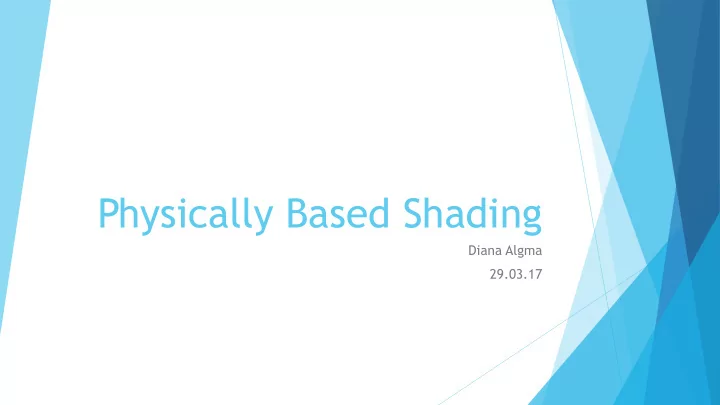

Physically Based Shading Diana Algma 29.03.17
I will talk about What is Physically Based Shading? Why is it good? Light physics Diffusion and reflection ( Why does snow appear white?) Fresnel effect Microsurface Conductors vs insulators Energy conservation Simple rendering example Examples of PBS
What is PBS, why is it good? Shading that models how light behaves in reality Follows principles of physics: Energy conservation Fresnel reflections Much more One shader for many different lighting conditions
Light
Reflection vs Diffusion
Reflection vs Diffusion
Diffusion
Reflection
Reflection & Diffusion
Fresnel Effect Any material can act as a perfect mirror if it is smooth and viewed at the right angle
Fresnel Effect
Fresnel Effect Any material can act as a perfect mirror if it is smooth and viewed at the right angle The curve or gradient between the angles does not vary much from material to material
Fresnel Effect
Fresnel Effect
Fresnel Effect
Microsurface “Gloss” “Smoothness” “Roughness”
Microsurface
Conductors vs Insulators Conductors – 60-90% reflectiveness Insulators – 0-20% reflectiveness Conductors – reflectivity can vary across the visible spectrum -> tinted reflections Conductors will absorb rather than scatter light -> metalness
Energy Conservation I Objects never reflect more light than they receive Before doing diffuse shading, simply subtract the reflected light
Energy Conservation II Rougher surface -> smoother surface Large, dim highlights -> small, sharp highlights
Rendering Equation
Rendering Equation
Rendering Equation BRDF - Bidirectional reflectance distribution function Conservation of energy:
Translating it to code Two problems: Representing all the radiance functions Solving the integral fast enough
Representing all the radiance functions Environment maps (cube maps)
Solving the integral fast enough Optimize BRDF depends on incoming radiance (which could be constant) Using Lambert’s BRDF:
Solving the integral fast enough Now integral depends on only the incidence angle of the light ray Precalculate it and store the result in a cubemap
Solving the integral fast enough
The code
The code
The result
Unity 5
Art
Overgrowth vs PBR
Overgrowth vs PBR
References Basic Theory of Physically-Based Rendering by Jeff Russell https://www.marmoset.co/posts/basic-theory-of-physically-based-rendering/ Interaction of Light and Materials http://www.pernroth.nu/lightandmaterials/ Article - Physically Based Rendering http://www.codinglabs.net/article_physically_based_rendering.aspx Nicolas Holzschuch, Romain Pacanowski. A physically accurate reflectance model combining reflection and diffraction. https://hal.inria.fr/hal-01224702/file/RR-8807%20(1).pdf Background: Physics and Math of Shading by Naty Hoffman http://blog.selfshadow.com/publications/s2013-shading- course/hoffman/s2013_pbs_physics_math_notes.pdf
References Physically Based Shading in Unity 5: A Primer https://blogs.unity3d.com/2014/10/29/physically-based-shading-in-unity-5-a- primer/ Global Illumination in Unity 5 https://blogs.unity3d.com/2014/09/18/global-illumination-in-unity-5/ Physically-Based Rendering, and You Can Too! https://www.marmoset.co/posts/physically-based-rendering-and-you-can-too/ “ Real- Time Rendering, 3rd edition” by Tomas Akenine-Möller, Eric Haines, and Naty Hoffman http://www.realtimerendering.com/ http://blog.teamtreehouse.com/beginners-guide-physically-based-rendering- unity
References https://www.marmoset.co/skyshop/ https://en.wikipedia.org/wiki/Rendering_equation http://www.ogre3d.org/forums/viewtopic.php?f=25&t=82936 http://wiki.ktxsoftware.com/Physically-Based-Rendering.html http://blog.wolfire.com/2015/10/Physically-based-rendering Picture from the game Ryse (and many more examples from games) http://www.neogaf.com/forum/showthread.php?t=1031164 https://media1.britannica.com/eb-media/80/150780-004-83AAD576.jpg
Recommend
More recommend